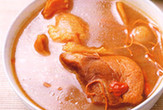Chinese folk art is a visual art created by ordinary people to meet ordinary social needs.
The definition of folk art is relative to the definition of the art of imperial palace, the art of aristocrats, and the art of scholars and of the literati, or professional artists. Firstly it is a communal art created by millions in the working class, not the work of a few career artists. It is the art of the laborers, not the professionals; it is amateur, not specialized. Secondly, its social function makes it an art of' necessity, used in everyday life, production, rites and ceremonies, and beliefs and taboos. It was not intended as a commercial commodity, nor to serve political needs.
Looking back on history to the age of primitive society, communal art was created by the Chinese people alongside the creation of tools, shelter and other basic appliances necessary in daily life. The emergence of social classes in society separated the art of the private career artist from folk art, thus forming two major art systems and two cultural heritages in China. The former was the communal art of the people and first came into being in prehistoric time; the latter was the art created by individual career artists and professionals. The parallel growth and mutual influences of these two types of art have been key in driving forward the mainstream of Chinese national art.
In terms of the conservation of national culture, the life of folk art is relatively stable. It represents the ideology of the community; the emotional and psychological characteristics of a nation throughout major periods in history. It is coexistent with national culture; it will not disappear as long as the community exists. Traditional folk art will, however, continue to grow and expand with the passage of time. Cross-cultural exchange and development will continually inject new life into folk art by bringing fresh materials and ideas. Its core, however--its cultural and philosophical origin, its Chinese cultural genes--will remain unchanged.





Why not rent a boyfriend, or girlfriend to please parents during the Spring Festival?